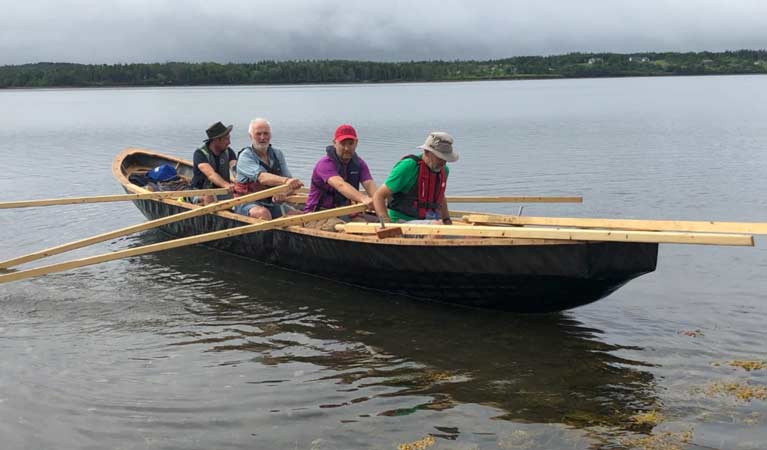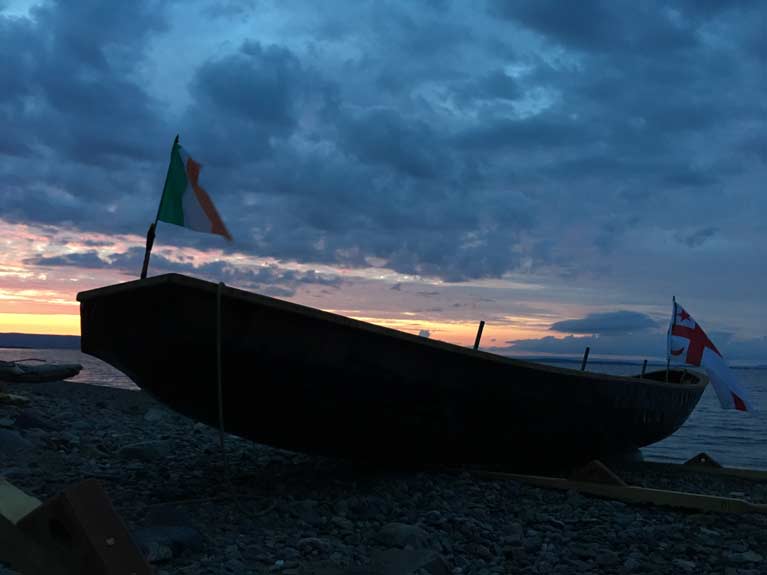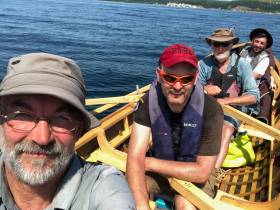Displaying items by tag: Seán Mac an tSíthigh
Four Irish Men Take Kerry Naomhóg Across Cape Breton
When Kerry Blasket islanders built the naomhóg for fishing, they would never have dreamed the same craft might transit Nova Scotia writes Lorna Siggins
However, four Irishmen have now rowed and sailed a similar design across Cape Breton in northern Canada.
The voyage has been undertaken by musician Breanndán Ó Beaglaoich, fellow Kerrymen Eamonn O Muircheartaigh and Seán Mac an tSíthigh and Kilkenny-based artist Liam Holden.
The 8-metre craft was constructed in Cape Breton last year as part of a Celtic Colours International Festival, Ó Beaglaoich explains.
 (Above and below) The 8-metre naomhóg has been rowed and sailed across Nova Scotia's Cape Breton by a four-man Irish crew
(Above and below) The 8-metre naomhóg has been rowed and sailed across Nova Scotia's Cape Breton by a four-man Irish crew

Nova Scotia artist Rosie MacKenzie issued the invitation to Ó Beaglaoich, who, with Holden, completed the “Camino by sea” voyage from Ireland to Spain between 2014 and 2016 in a Kerry naomhóg.
That three-summer voyage in the Naomh Gobnait involved Kerry poet Danny Sheehy, Breandán Moriarty and musician Glen Hansard, and Sheehy died the following year during a continuation of the journey to the Portuguese border.
Sean Mac an tSíthigh, an RTÉ and TG4 journalist on this Nova Scotia crew, is a nephew of the Kerry poet.
 Naomhóg crewman Sean Mac an tSíthigh (left) with Nova Scotia lightkeepers grandson John Murray
Naomhóg crewman Sean Mac an tSíthigh (left) with Nova Scotia lightkeepers grandson John Murray
The crew have received a very warm welcome during their transit, and made the front page of the local Cape Breton Post newspaper, which observed that the naomhóg was constructed from five types of local wood.
“We camped en route, made music and we were like a magnet for people, “Ó Beaglaoich said.
“I think the simplicity of the naomhóg has a particular appeal,” he said.
The crew began their voyage in late July in Louisdale and participated in a prayer meeting with the Mi’kmaq indigenous community when they landed on Chapel Island. They continued on to Roberta and Crammond islands.
Among Cape Breton residents who have assisted them is John Murray, who was reared on a remote Cape George lighthouse where his grandfather was a keeper.
Murray was one of 13 children, reared on deer and rabbits, wearing buffalo skin during winter when the road was often under four metres of snow. At the age of 14, he left to work on ore freight vessels on the Great Lakes.
 The County Kerry naomhóg ashore in Cape Breton
The County Kerry naomhóg ashore in Cape Breton
“We’ve been using the sail as much as we can, and the rowing has been wonderful in these waters,” he said.
The crew has just returned from St Paul’s island, about 24 km north-east of Cape Breton, which is uninhabited.
The crew were supported on that trip by Ron Ingram (99), who had fished on St Paul’s but hadn’t been back there for 30 years, according to Ó Beaglaoich.
“He was a most wonderful man, still hanging nets at 99...as we were leaving, he said to me with a happy face that he never thought he would see the sunshine over St Paul’s anymore...”
Naomhóg Chorca Dhuibhne i gCeap Bhreatain....
— Seán Mac an tSíthigh (@Buailtin) August 1, 2019
The music of a West Kerry ‘naomhóg’ in Nova Scotia... pic.twitter.com/uyGNlEaQzG





























































